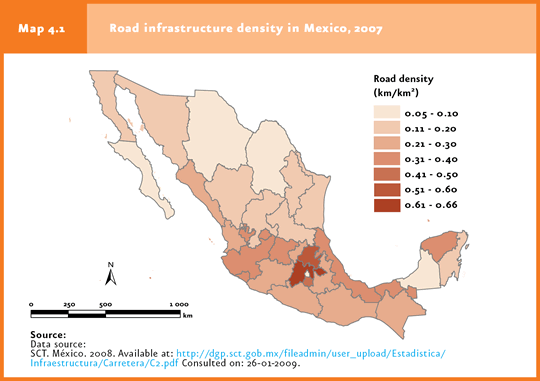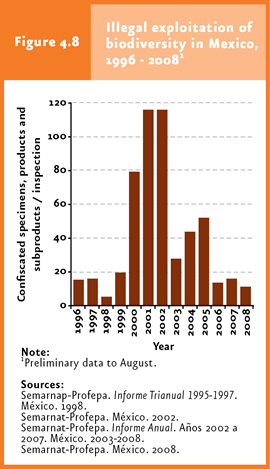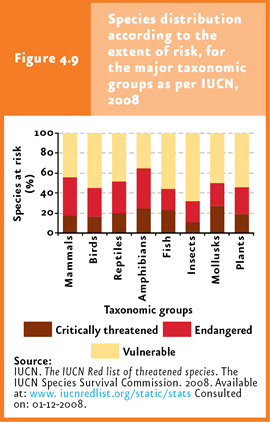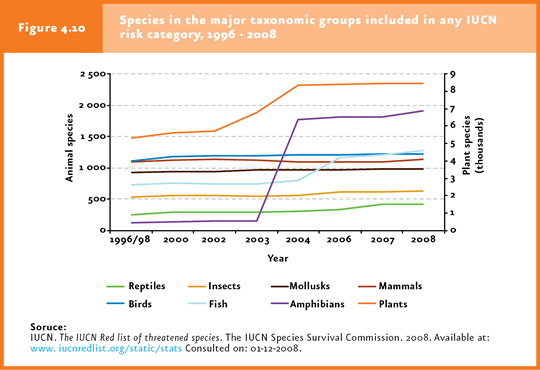
CONABIO has identified 362 invasive species in Mexico: 134 plants, 63 fish, 9 amphibians and reptiles, 7 birds and 15 mammals. |
According to NOM-059-SEMARNAT-2001, the total number of wildlife species likely to be extinct in Mexico is 41 (19, birds; 11, fish; 7, mammal; 4, plants). |
According to IUCN, the number of extinct species as a result of anthropogenic process until the year 2008 goes up to 924 including 134 bird species, 91 fish species, 87 plants and 76 mammals. |
| CHAPTER 4. BIODIVERSITY |
Terrestrial ecosystems Virtually every corner of the Earth has been transformed by human activities. During the past 100 years, man has inflicted changes in ecosystems more rapidly and intensively than in any other period of history, to meet the growing demand for space, food, freshwater and energy, among others. The main threats to biodiversity, both in Mexico and worldwide, are changes in land use (mostly derived from the expansion of the farming and urban borders), demographic grow, infrastructure construction (e. g. roads, electricity distribution networks and dams), the introduction of invasive species, forest fires, natural resource overexploitation, illegal exploitation and, most recently, the global climate change. As a result of its demographic growth and development, Mexico has transformed and disrupted its ecosystems to a significant extent. In the year 2002, according to INEGI estimates, only 73% of the original natural vegetation remained. However, the remaining natural vegetation shows evident signs of deterioration: only 68% of natural vegetation is primary vegetation, with tropical forests being the most severely affected vegetation type (just 35% of tropical forests existing today may be classified as primary vegetation; IC 1). Between 1993 and 2002, the forest was the ecosystem losing the greatest area of primary vegetation (including both temperate and mountain cloud forests, with nearly 2.6 million hectares, at a 1.24% annual rate), followed by xerophilous shrubland (nearly 837 thousand hectares at a 0.2% rate) and tropical forests (which lost approximately 836 thousand hectares at an annual rate of 0.8%; Figure 4.6). During this same period, national wetlands reduced their extension in 95 thousand hectares (0.42% per year), and, taken together, halophile and gypsophile vegetation, riparian vegetation and natural grasslands lost nearly 201 thousand hectares, at an annual rate of 0.15%. In general, deforested areas are usually allocated to agriculture and cattle-raising. However, the area dedicated to agriculture has not increased significantly over the past years, suggesting that the destruction of natural ecosystems has not translated into a natural increase in productive areas. For further details of land-use changes in Mexico please refer to the Terrestrial ecosystems chapter.
Although changes in land use have important effects on biodiversity, infrastructure construction (including roads, broadening of electricity networks or construction of dams) can also seriously affect wildlife. The most significant effect of infrastructure growth includes the loss and modification of ecosystems, the fragmentation of remaining natural vegetation and, in the case of roads, the death of animals. In the country, road infrastructure grew some 57,322 kilometers between 1997 and 2007, from 303,000 to 360,000 kilometers, that is, nearly 5,700 kilometers per year. Despite no formal studies on the environmental impacts of road infrastructure have been conducted in Mexico, when the relationship between road density and natural plant cover is examined, it is evident that, in general, the states with the highest road density also include the smallest area covered by natural vegetation (Figure 4.7; Map 4.1). States like Tlaxcala, which have the highest road density in the country (about 0.65 km/km2) possesses the lowest natural cover in Mexico (18.2% of its area); in the other end, Chihuahua (with the lowest road density in Mexico, 53 m/km2) keeps 89.3% of its natural vegetation. It is worth mentioning that, although road construction is not the only factor promoting the disappearance of terrestrial natural ecosystems – with its lowering effect on biodiversity -, it does cause a negative effect on them by fostering settlements and development of new towns or the exploitation of natural resources. Examples of this phenomenon have been reported in association with road construction in the Brazilian Amazon forest (UNEP, 2005).
On the other hand, after habitat destruction, the impact derived from invasive species is deemed the second most important cause of biodiversity loss at a world level (Vitousek, 1996; Leung et al., 2002; refer to box The global biological invasion). Invasive species affect native animal and plant species through competition, predation, and transmission of diseases, habitat modification and disruption of the trophic structure. Furthermore, under special circumstances, invasive species may crossbreed with native ones, thereby modifying the genetic pool of the latter (CONABIO, 2006). Invasive species are introduced in foreign ecosystems through a number of ways: 1) transportation (including transportation media as such, military equipment and motor cars, products used for shipping and delivery of goods, companies conducting tourism and transportation of animals for recreational purposes, among others); 2) trade (e. g. animals and plants produced for human consumption, aquatic and terrestrial plants for agriculture, gardening, horticulture or research, among others); 3) other human activities, including reforestation, road construction, mining, land-use changes, biological control and the merge of previously isolated water bodies; and 4) natural events like hurricanes and flooding. In our country, the Information System on Invasive Species in Mexico (SIEIM in Spanish), under CONABIO, has identified a total of 362 invasive species, including 134 plant, 63 fish, 9 amphibian and reptile, 7 bird and 15 mammal species. These species are categorized as high-risk and top-priority in Mexico (refer to Box Invasive species in Mexico: the case of the prickly-pear cactus moth). Forest fires can also represent a threat for terrestrial biodiversity, mostly through the loss of natural vegetation, mainly during the dry season. Forest fires occur naturally and constitute a key factor for the dynamics in many forest ecosystems worldwide, mostly in temperate forest and some dry shrublands. Fire influences the processes that determine soil nutrient availability and promotes the ecological succession processes which contribute to preserve biodiversity. Currently, however, to a great extent as a result of human activities and fire-controlling measures, the occurrence patterns of natural fires have changed. Today, many forest fires take place in areas that were not previously affected by them, and at the same time these have been prevented in areas which were formerly subjected to regular fires. This change may be particularly harmful in some ecosystems, like evergreen rainforests and mountain cloud forests. Forest fire exerts multiple effects on ecosystems, which depend on fire intensity and frequency. Its major effect is the elimination of plant biomass, which delays or prevents natural regeneration, besides fostering the development of pests and forest diseases. In the case of animals, many individuals of some species (mostly those with poor mobility), succumb to fires, reducing population size and even leading to local extinctions. During the period 2000-2008, an annual average of 7,965 forest fires were recorded, affecting an average area of over 211,000 hectares per year (Cuadros D3_RFORESTA05_01 and D3_RFORESTA05_02; IB 7-3). To note, 1998 was a particularly devastating year in terms of forest fires in the country, with 14,445 fires recorded which affected an area of about 849,632 hectares. Most of the area affected that year corresponded to grasslands, shrublands, and around 23% corresponded to forest areas (Cuadro D3_RFORESTA05_03: CONAFOR, 2008). Illegal wildlife exploitation is also an activity that threatens biodiversity. These practices include poaching, capture, collection, transportation and trade of wildlife specimens. these are jointly regarded as the third most important illegal activity worldwide in terms of the income derived from them, after drug and weapon trafficking (CONABIO, 1998). In Mexico, between 1996 and 2006, the average of wildlife specimens, products and subproducts confiscated as a result of inspection operations displayed an irregular pattern: it peaked in the years 2001 and 2002, with around 115 items, followed by a decline in the years that followed to reach figures of up to 11 items per operation in the year 2008 (Figure 4.8; IB 6.4-1). It is worth mentioning that this information only accounts for the minimum detectable traffic, as the total volume of items illegally trafficked both within an outside the country remains unknown.
Last, the global climate change currently is and will be one of the most important stress factors that jeopardize the persistence of ecosystems and species in Mexico and worldwide. It is foreseen that its effect will result in modifications in the distribution of many plant and animal species, at a rate that will surpass their adaptation capability in many cases, leading them unavoidably to extinction. The Atmosphere chapter, section Climate change, expands on the effects of this global issue on biodiversity.
Threatened species The reduction in the population sizes of many species as a result of human activities (by any of the factors mentioned above), may compromise their permanence in natural ecosystems and lead them to extinction in the short-, mid-, or long term. Of particular concern are those of species with very restricted distribution areas (on occasions stretching to just a few hectares, or inhabiting islands or water bodies), those with small population sizes or which display life cycles particularly sensitive to environmental changes. In Mexico, the standard NOM-059-SEMARNAT-2001 lists the animal and plant species and subspecies which are categorized as threatened. According to this standard, plants currently represent the taxonomic group with the largest number of threatened species (both angiosperms and gymnosperms), with 981 species. Among them, families with a largest number of threatened species are cacti (285 species, equivalent to 43% of total species described in the country), orchids (181 species, 16%), palm trees (64 species, 54%) and agave species (39 species, 18%). Among animals, the groups with the largest number of threatened species are reptiles (466 species, that is, 58% of species known in the country), birds (371, 30%), mammals (295, 62%), amphibians (197, 55%) and fish (185, 9%). According to the official standard, the total number of wildlife species likely to be extinct total 41 (19, birds; 11, fish; 7, mammal; 4, plants). To this respect, in the year 2005 SEMARNAT promoted actions to update the lists of threatened species included in the 2001 standard. As a result, the project to amend the Mexican Official Standard NOM-059-SEMARNAT-2000 was published in the Federation Official Gazette in December 2008, elaborated jointly by government and private organizations. According to this document, the number of threatened species rose in 27 species: 21, birds; 5, fungi. By contrast, 10 plant species may be removed from the list of threatened species. In general terms, the rise totals 37 species, up from 2,583 to 2,620 species. At a world level, according to the 2008 Red List of Threatened Species issued by the International Union for the Conservation of Nature (IUCN), 16,928 species may be categorized in any of the threatened categories: 3,141 are deemed critically endangered of extinction, 4,603 as endangered and 8,283 as vulnerable1. When this list is analyzed by taxonomic group, it is evident that plants are the most vulnerable group worldwide, with nearly 8,457 species included in the list, followed by amphibians (1,905 species), fish (1,275), birds (1,222) and mammals (1,141). The percentage of species in the different risk categories per taxonomic group is shown in Figure 4.9.
The inclusion of species in the IUCN list has significantly grown in the past years for some taxonomic groups (Figure 4.10). In the case of plants, the number of species went from 5,328 in 1996-1998 to 8,457 species in the year 2008, that is, nearly 313 species per year. Significant rises have also been recorded in amphibians (from 124 to 1,905 species in the same period; refer to Box Global amphibian crisis) and fish (from 734 to 1,275 species). Although the extinction of species is a natural process, during recent years the extinction rate recorded worldwide is more than 1000 as high as the one estimated from fossil records (MEA, 2005). At the world level, according to IUCN, the number of extinct species as a result of anthropogenic processes until the year 2008 amounts to 924, including 134 bird, 91 fish, 87 plant and 76 mammal species (refer to Box The global extinction).
Note
|





